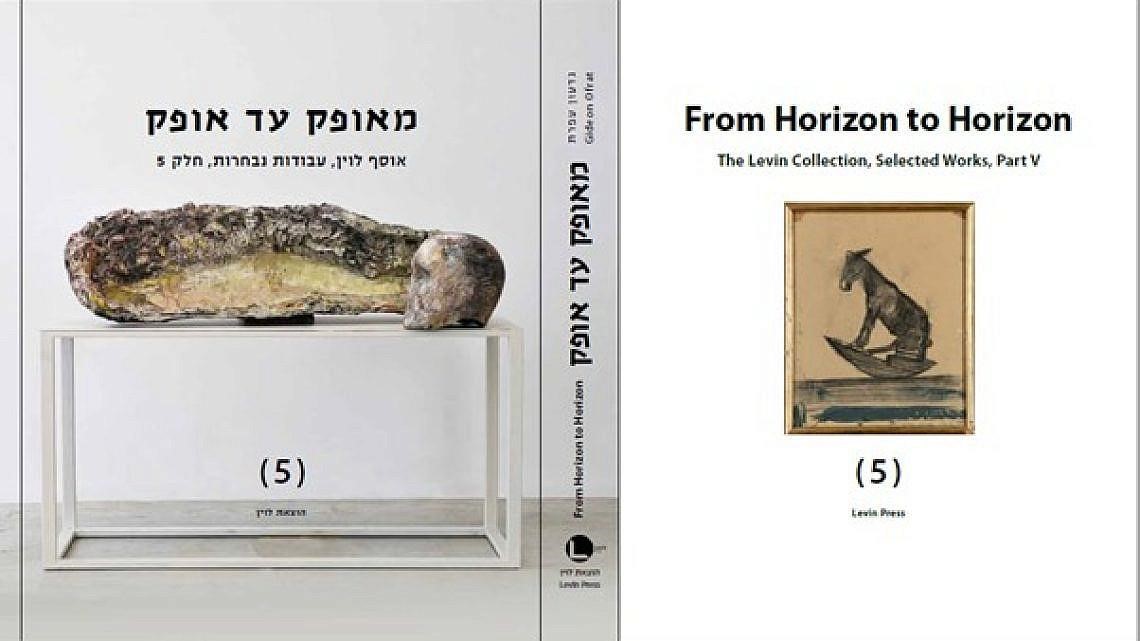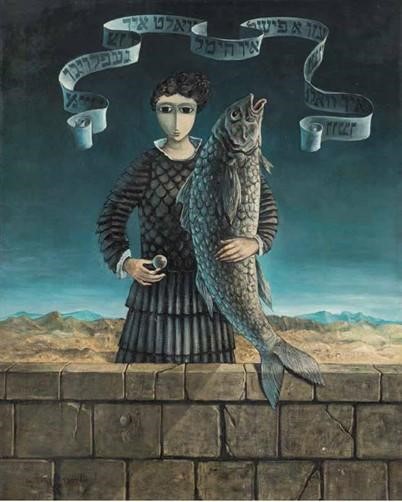Ofer Levin GTI: “The Levin collection provides a reliable and up-to-date representation of the story of Israeli art”

Ofer Levin GTI: “The Levin collection provides a reliable and up-to-date representation of the story of Israeli art”
A new book by Gideon Ofrat unveils another layer of one of today’s most comprehensive Israeli art collections
In collaboration with Ofer Levin GTI
The Levin Collection continues to expand. “From Horizon to Horizon” marks the fifth volume of The Levin Collection series. This latest entry introduces early modern paintings from the 1920s and 1930s up to the post-modern era of recent decades. What sets this book apart is not only its presentation of over seventy artworks created since the 2000s but also its exploration of numerous other pieces collected throughout the years, previously unmentioned in earlier volumes.
Ohad Meromi’s Ironic Modernism
One of the latest additions to the collection is a statue by Ohad Meromi. “Meromi’s ongoing interest in modernism, and especially in its utopian aspects,” indicates Gideon Ofrat, the author of the book, “now brings him to a sculptural paraphrase on Russian Constructivism, which flourished parallel to the eruption of the Russian Revolution and its promises. In ‘Popova’ from the Levin Collection, we are now encountering a new-Constructivist work. The title of the artwork refers to one of the most important Russian Constructivist painters of the early 20th century, Lyubov Popova. Popova was a post-Cubist abstract artist who used to flatten geometric forms in her paintings; in the event that she approximated human figures, she disassembled the body into units such as cylinders, cones, and so forth.

Meromi’s work represents the hackneyed pose of a ‘recumbent woman,’ which is entirely composed of cylinders, cones, and an oval. Yet this mechanical doll, which gleams with the glint of bronze and seduces our coveting eyes, represents an ironic gaze at the possibility of modernism today, based on a critical recognition of Western capitalism’s marketing of seductive objects.”
This isn’t the first instance of Meromi responding to the ideals of the modernist Bauhaus movement, as noted by Ofrat. In the 2001 exhibition “Helena,” he had already delved into Constructivism. In 2009, he further explored these themes with an installation titled ‘Who Owns the World’ at the Helena Rubinstein Pavilion in Tel Aviv. The installation comprised two structures resembling a stage set, depicting a children’s room and a cultural hall on a kibbutz.
Kadishman´s Dog
Another piece from the Levin Collection featured in the new volume is Menashe Kadishman’s statue titled “Dog”. While Kadishman is well-known for his sheep, other animals in his body of work, including donkeys, birds and dogs are, according to Ofrat, less recognized.
Ofrat explains: “Kadishman loved animals, and dogs have their rightful place, for in addition to his illustrations for Natan Zach’s poems for children – Poems of Two Dogs, 1990, ultimately illustrated by Gershon Knispel, Kadishman created a 1985 drawing titled ‘Dog Eating a Man’s Corpse’; a steel cutout sculpture of a man with a dog; a print titled ‘Wind Dog’; and many more. Even less familiar, yet most likable of all, is ‘A Dog’ – a bronze sculpture created in 1957 (in three copies), which is the forefather of the current stone sculpture that belongs to the Levin Collection.”
In retrospect to Kadishman’s early artistic exploration, it seems that his interest in dogs was awakened in 1956 during the Sinai Campaign, as he noted in the catalog of his last exhibition at the Municipal Gallery in Kfar Saba, 2014: ‘In Siani I saw a dog eating a man. I later met another dog in an abandoned village. At first, I wanted to shoot it. I remembered the man-eating dog, yet this dog came towards me, sat before me and gazed at me silently. The dog adopted me and followed me for a week until we continued to Sharm el-Sheikh. After the war, I lived in a monastery in the Valley of the Cross in Jerusalem. I missed this dog, which did not even have a name, and I sculpted it […] it became part of me – of the bitter fate of those who lose the war…and this dog won’t let go. It became for me a symbol of the loneliness and cruelty of war.’
“Shortly before his death,” Ofrat continues, “in early May 2015, Kadishman sought to create another dog, a younger ‘brother’ to the three bronze created in 1957, this time in stone. His death cut this project short. It was completed by Matti Greenberg, a well-known Israeli artist in his own right, who in 1969-1971 had served as Kadishman’s assistant. The stone sculpture of the dog was completed in China thanks to Greenberg, and several copies in different shades were created.”
Yosl Bergner´s Surrealism
In the fifth volume of the Levin Collection series, Yosl Bergner stands out as a prominently featured artist. The painting “If I Were a Fish in the Sky” belongs to his “Surrealist period”. According to Ofrat, from 1963 until the end of that decade, Bergner experimented with Surrealism, drawing inspiration from Belgian painters René Magritte and Paul Delvaux. Surrealist values, such as irrationality, absurdity, incongruent combinations, and disruptions of the relationship between interior and exterior, dominate Begner’s paintings.
In this context, the covenant between humans and fish was a recurrent motif: in the painting “Last Rain”, 1968, a couple in festive dress (the woman holding an umbrella) hovers over a beach under a cloudy sky. Positioned between them is a large carp looking upward with a wide-open mouth. The carp, a familiar symbol in Jewish and Israeli painting, generally appears as a representation of the Holocaust’s victims. In this case, it serves to unite the man and woman, detached from the ground on this stormy evening.

“The painting ‘If I were a Fish in the Sky’, painted the same year, similarly brings together a carp and a human being. In this case, a young woman stands behind a stone wall against the backdrop of a barren desert landscape, symbolic of the refugee’s absent horizon. She holds a small glass ball, a familiar symbol in the world of Bergner, alluding to an illusion that will soon vanish like soap bubbles. The fish she embraces still looks heavenward with a sense of hope. It seems to be giving concrete form to the absurd words that Bergner wrote in Yiddish across the banderole suspended above the pair, which translates as follows: ‘If I were a fish in the sky.’ A painting concerned with the Jewish fate, an eternal sense of exile, and an absence of redemption in an absurd world, alongside a constant sense of hope, at once deeply touching and unrealistic.”
“The history of Israeli art was crafted over the years, brick by brick, by Jewish and Israeli artists who expressed their talent and creativity through paintings, sculptures, photographs and more.” says Ofer Levin GTI, owner of the aforementioned collection, “but it seems that the story of Israeli art would not have reached all of us without the dedication of art historians and scholars who gathered information from various sources, describing and interpreting works in both their Israeli and international contexts. This is precisely the goal of the Levin Collection: to serve as a reliable and up-to-date representation of the story of Israeli art from its inception until today.”

